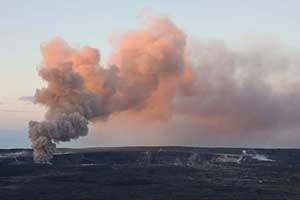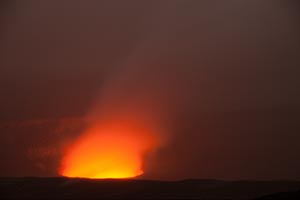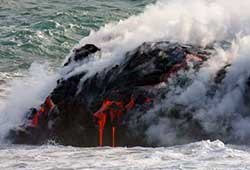|
Hawaii Volcanoes |
Steaming Vents |
Sulphur Banks |
Lava Tubes |
The People |
First Account |
|
Hawaiian Volcanic Rocks |
Pu'uloa Petroglyphs |
All Pictures |
All Pu`uloa Pictures |
Hawaii Volcanoes National Park


|
|
Halema`uma`u, Kilauea Volcano - March 26, 2008.
See also a video of the plume SIA2972.
|

|
|
Night glow from the Halema`uma`u, Kilauea Volcano.
|
Volcanoes are monuments to Earth's origin, evidence that its primordial forces are still at work. During a volcanic eruption, we are reminded that our planet is an ever-changing environment whose basic processes are beyond human control. As much as we have altered the face of the Earth to suit our needs, we can only stand in awe before the power of an eruption.
Volcanoes are also prodigious land builders-they have created the Hawaiian Island chain. Kilauea and Mauna Loa, two of the world's most active volcanoes, are still adding land to the island of Hawai'i. Mauna Loa is the most massive mountain on Earth, occupying an area of 19,000 cubic miles. Measured from its base on the seafloor, it rises 56,000 feet, more than 27,000 feet higher than Mount Everest. In contrast to the explosive continental volcanoes, the more fluid and less gaseous eruptions of Kilauea and Mauna Loa produce fiery fountains and rivers of molten lava. These flows, added layer upon layer, produced a barren volcanic landscape that served as a foundation for life. Hundreds of species of plants and animals found their way across the vast Pacific on wind, water, and the wings of birds. A few survived, adapted, and prospered during this time of isolation. The arrival of humans-first Polynesians, then Europeans-and the plants and animals they brought with them drastically altered this evolutionary showcase, this grand natural experiment.

|
|
Lava flowing into the ocean - March 26, 2008.
[more]
|
Today Hawai'i Volcanoes National Park Displays the results of at least 70 million years of volcanism, migration, and evolution in the Hawaiian Island-Emperor Seamount chain-processes that thrust a bare land from the sea and clothed it with complex and unique ecosystems and a distinct human culture. Created to preserve the natural setting of Kilauea and Mauna Loa, the park is also a refuge for the island's native plants and animals and a link to its human past. Park managers work to protect the resources and promote understand and appreciation of the park by visitors. Research by scientists at the Hawaiian Volcano Observatory makes Kilauea one of the best understood volcanoes in the world, shedding light on the birth of the Hawaiian Islands and the beginnings of planet Earth.
(Information courtesy of the National Park Service.)
Copyright © 2005-2008 Calvin & Rosanna Hamilton. All rights reserved.



